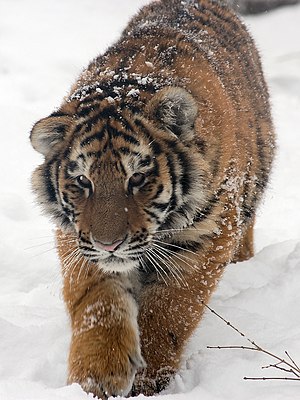Siberian Tiger: Subspecies of mammal
The Siberian tiger or Amur tiger (Panthera tigris tigris) is the largest felid in the world.
They live in eastern Russia's birch forests, and there are some in China and North Korea. It is estimated that there are around 400 to 500 Siberian tigers left in the wild.
| Siberian tiger | |
|---|---|
 | |
| Male | |
 | |
| Female | |
| Scientific classification | |
| Domain: | Eukaryota |
| Kingdom: | Animalia |
| Phylum: | Chordata |
| Class: | Mammalia |
| Order: | Carnivora |
| Suborder: | Feliformia |
| Family: | Felidae |
| Subfamily: | Pantherinae |
| Genus: | Panthera |
| Species: | |
| Subspecies: | P. t. tigris |
| Trinomial name | |
| Panthera tigris tigris (Linnaeus, 1758) | |
 | |
| Distribution of the Siberian tiger (in red) | |
In 2017, the Cat Specialist Group revised felid taxonomy and now recognizes all the tiger populations in mainland Asia as P. t. tigris.
Description
Siberian tigers are the largest of all tigers, as well as the largest of all the big cats. They can grow up to the length of 10-12 ft (3–3.65 meters), but some can be as long as 13 feet (4.0 m). They usually weigh around 550–750 pounds, and weigh 650 pounds on average. To keep themselves from becoming cold in the winters, Siberian tigers have thicker fur coats than tigers which live in southern Asia. They also have a thick layer of fat which helps keep them warm. Like all other tigers, Siberian tigers have orange fur with black stripes. Siberian tigers have extra fur around their necks and paws which helps them keep warm. Siberian tigers have less orange in their coats, and have fewer stripes.
Where they live
Siberian tigers are located in northeast China, the Russian Far East and parts of North Korea. This region is called the "Amur Region", which is named after the Amur River. This region is covered with mountainous areas and coniferous forests. In the summer, the temperature is between mild and hot. In the winter, it may be very cold, especially at higher altitudes.
Behaviour
Like other tigers, the Siberian tiger likes to live on its own. Each Siberian tiger has its own large amount of territory. Male tigers' territories will usually cross those of several females' territories, but will usually not cross the territories of other males. In their territories, Siberian tigers usually have a lair in a cave or another area.
Feeding
Since Siberian tigers live in such cold regions, an adult needs to eat at least 9 kilograms (20 lb) of food every day to survive, but adults can eat as much as 50 kilograms of meat. Siberian tigers are carnivores. Siberian tigers are apex predators. Siberian tigers feed mainly on wild boar, moose and deer. If regular prey is unavailable they will eat fish, rodents, rabbits, wolves, asian black bears, and even small brown bears. During normal conditions, around 50 percent of the tiger's diet will be of wild boar.
Hunting
While hunting, a Siberian tiger can run up to speeds of 40 miles per hour (64 km/h), but running at this speed takes a lot of energy, so the Siberian tiger will only run short distances. The Siberian tiger has good night vision and likes to hunt during the night, when it can more easily surprise its prey. It also has excellent hearing and sense of smell which it uses to find and attack prey.
Reproduction

Siberian tigers live alone and only come together in mating season. The mating season usually begins in December, and lasts through January. Females are pregnant for around three to three and a half months before giving birth to their cubs in early spring. Females usually give birth to around 3–4 cubs at a time. When born, the Siberian tiger cub is blind and toothless and is no larger than a normal house cat. It stays blind for around two weeks. The mother starts teaching the cubs how to hunt when the cubs are around 1 year old. The cubs then stay with their mother until they are 3–5 years old.
References
Other websites


- "The Amur tiger in the 20th century" Archived 2006-01-17 at the Wayback Machine article from the Tigris Foundation website
- Siberian Tiger at the AMUR website Archived 2005-11-25 at the Wayback Machine
This article uses material from the Wikipedia Simple English article Siberian tiger, which is released under the Creative Commons Attribution-ShareAlike 3.0 license ("CC BY-SA 3.0"); additional terms may apply (view authors). Content is available under CC BY-SA 4.0 unless otherwise noted. Images, videos and audio are available under their respective licenses.
®Wikipedia is a registered trademark of the Wiki Foundation, Inc. Wiki Simple English (DUHOCTRUNGQUOC.VN) is an independent company and has no affiliation with Wiki Foundation.
